Natural Science
Vol.5 No.1(2013), Article ID:27671,6 pages DOI:10.4236/ns.2013.51015
Measurement of radon concentrations in soil and the extent of their impact on the environment from Al-Qassim, Saudi Arabia
![]()
1Physics Department, Faculty of Science, King Abdulaziz University, Jeddah, KSA
2Physics Department, Faculty of Science, South Valley University, Qena, Egypt; *Corresponding Author: wd_alharbi@yahoo.com
3Physics Department, Faculty of Science, Al Jouf University, Al Jouf, KSA
Received 5 November 2012; revised 8 December 2012; accepted 20 December 2012
Keywords: Natural Radioactivity; Radon; Soil; Alpha Guard
ABSTRACT
Soil gas radon 222Rn concentration was measured at 12 location in the Al-Qassim area, using radon gas analyzer-type Alpha GUARD 2000 PRQ from Genitron Instruments (Germany). In each location four different depths were taken for soil gas measurements, staring from the ground surface. The results suggested that the largest concentration was 340 ± 22 Bq/m3 for 60cm depth at in Al-Tarfia point sample P3, and the smallest concentration was 26 ± 5 Bq/m3 for surface 0 cm depth at El-Bakria, point sample P5. The results obtained from this study indicate that the region has background radioactivity levels within the natural limits.
1. INTRODUCTION
The knowledge on radioactivity contents of the various radio-nuclides in soil and rocks plays an important role in health physics. The naturally occurring radionuclides 226Ra. 232Th and 40K are the main sources of radiation in soils and rocks, from which traditional building materials are derived. These radio-nuclides pose exposure risks externally due to their gamma-ray emissions and internally due to radon and its progenies, which emit alpha particles [1]. The factors which influence the diffusion of radon from the soil into the air are: 1) The uranium and radium concentration in soil and rocks; 2) The emanation capacity of the ground; 3) The porosity of the soil or rock; 4) Barometric pressure gradient between the interfaces; 5) Soil moisture and water saturation grade of the medium; 6) Other variables [2]. Figure 1 presents Mechanisms of exhalation of radon and thoron from soil. Soils are naturally radioactive, primarily because of their

Figure 1. Mechanisms of exhalation of radon and thoron from soil.
mineral content. The natural radioactivity may vary considerably from one type of soil to another. The sources of radioactivity in soils other than those of natural origin are mainly due to:
1) Fallout from past atmospheric explosions of nuclear devices and following nuclear accidents-extensive use of fertilizers rich in phosphates for agricultural purposes;
2) Routine authorized low level radioactive effluent discharges or accidental release into the environment from nuclear fuel cycle installations, mineral extraction industries, industries working with mineral materials enriched in naturally radioactive elements, (e.g. fertilizer factories) and various economic sectors in which naturally or artificially radioactive elements are used [3].
The health risks of radon gas have been clearly recognized by international organizations. Radon is a known human carcinogen and is estimated to be the second leading cause of a lung cancer. Only smoking causes more lung cancer deaths. EPA [4] estimates that radon causes 21,000 lung cancer deaths each year in the US. By comparison, roughly 17,400 people die in the US as a result of drunk-driving accidents; 8000 die from falls in homes; 3900 drowning, and 2800 die of injuries caused by fires, as illustrated in Figure 2.
Recent results of radon measurements outdoors tend to confirm the estimates of typical outdoor 222Rn and 220Rn concentrations made in the UNSCEAR 1993 Report of 10 Bq∙m−3 for each [2]. There is, however, a wide range of long-term average concentrations of 222Rn, from approximately 1 to more than 100 Bq∙m−3, with the former perhaps typical of isolated small islands or coastal regions and the latter typical of sites with high radon exhalation over large surrounding areas. Although data are sparse for thoron, considerable variability from place to place would be expected because of thoron’s short halflife, which means that the effective surface source, about 0.1 km2, is much smaller than that for 222Rn, emphasizing the effect of local variations in exhalation rate. Even more important is the fact that thoron’s short half-life results in a very steep vertical gradient in its atmospheric concentration at any location [1].
In Saudi Arabia radon concentrations have been considered by the scientists as well and measured in several parts in the Kingdom. Abu-Jard and Al Jarallah published radon measurements in a total of 19 Khafji cities and discuss the first survey of this type in Saudi Arabia [5]. Abu-Jard et al., monitor radon in 1200 houses in four cities Hafr Al-Batin, Khafji, Madina and Taif [6]. Abu Jard et al., monitor radon in 2700 house and 98 school nine cities in Saudi Arabia seven in the eastern province Dammam, Abqaiq, Al Ahsa, Hafr Al Batin, Khafji, Qatif, and Khobar and two in western provinve Madina and Taif [6]. The lowest average radon concentration 8 Bq∙m−3 was found in Ahsa while the highest average concentration 40 Bq∙m−3 was found in Khafji. Al Jarallah and Fazul-u-Rahman, measured the radon concentrations in dwellings of Al Gouf region they found that the radon concentration varied from 7 Bq∙m−3 to 168 Bq∙m−3with
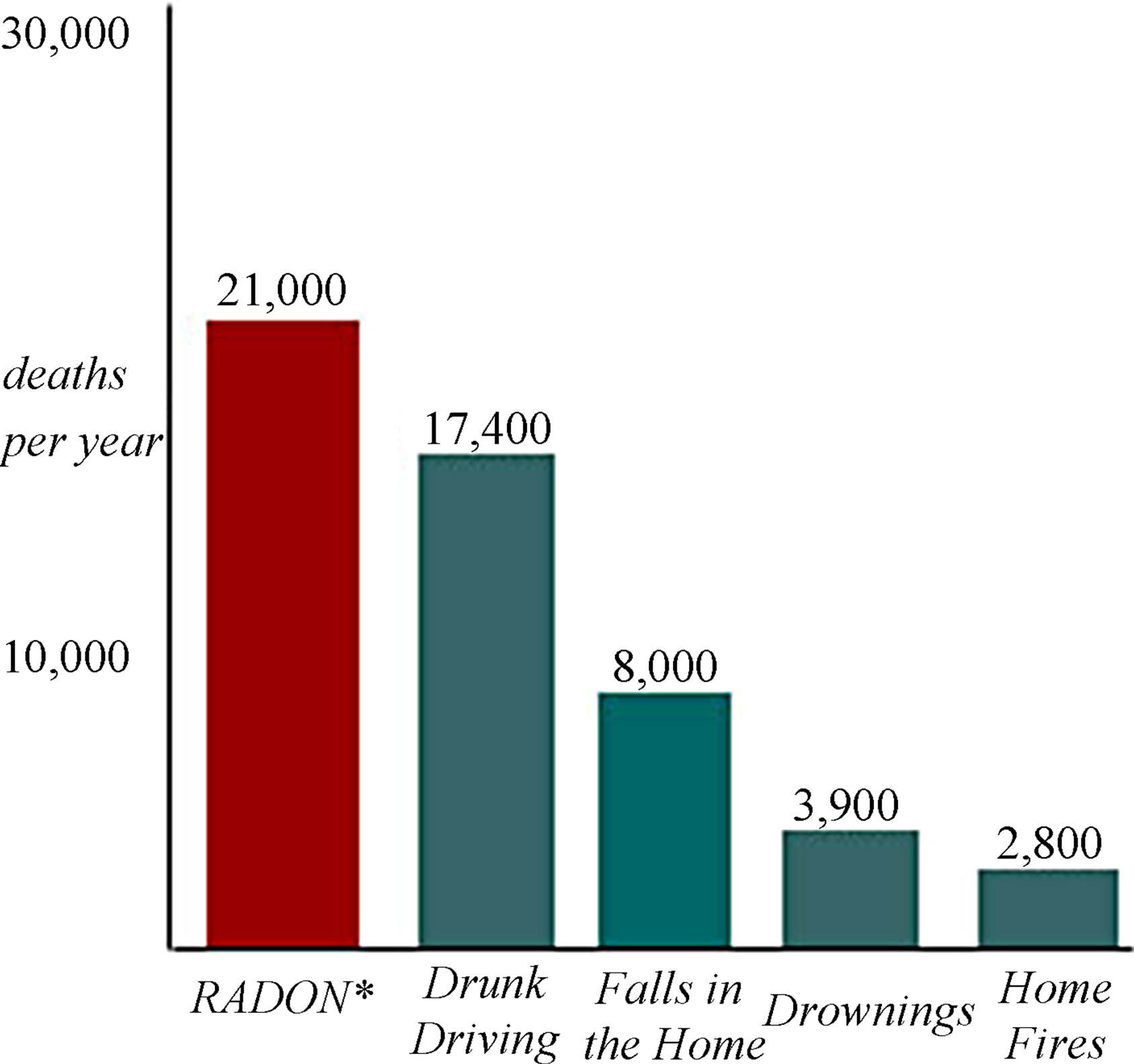
Figure 2. Number of deaths per year for each category (EPA 2003).
an overall average of 45 Bq∙m−3 for all surveyed dwellings [7]. There are also other studies deals with radon in Saudi Arabia cities [8]. In addition, there are academic programs in Saudi unversities concerened with the concentration of radon levels in areas in the Kingdom [9,10]. In addition to environmental value of the present paper, the results will be obtained are considered to be essential in analyzing any data for future activities in this field.
The aim of the paper to examine the concentration of radon gas in soil of Qassim region. The geology of the study area and the types of rocks, which requires the implementation of an integrated study to measure levels of radon and the products analyzed in order to know about the existence of high levels of radon gas and products, and analyzed by estimating the average radiation dose to the individual and linked to the national statistics of lung cancer in the region. This database will be used as reference to gauge any inputs and trans boundary radioactive release in future.
2. MATERIALS AND METHODS
2.1. Sampling: On-Site Activities
A radon gas analyzer type Alpha Guard 2000 PRQ from Genitron Instruments (Germany) was used to measure radon concentrations in soil from a total of 12 sample points in Al-Qassim area, Saudi Arabia. The study sites covered most part of the Al-Qassim area (Buraydah, ElBakria-Onaiza-El-Rass-El-Moznib). The Alpha GUARD is a portable, real-time ionization chamber. At present, there are about 1000 units in operation in the world. The Alpha Guard is a very popular and recognized as reference device for radon measurements because of its advantages. It can measure radon in air, soil, water and building materials, and it can simultaneously monitor air temperature (in the range from –10˚C to +50˚C), air pressure (from 700 mbar to 1100 mbar) and air humidity (from 0% to 99%). It can operate on internal battery for 10 days. The important feature of the Alpha Guard is its linear response from 2 Bq/m3 to 2 MBq/m3 of 222Rn concentration. A disadvantage of this device is that it detects alpha emitters without energy discrimination. For that reason, it is worth examining how much thoron presence can increase the result of radon measurement [11]. Figure 3 explains Alpha GUARD measuring equipment for the determination of radon soil gas concentration.
The measuring gas gets in diffusion mode via a large surface glass filter into an ionization chamber. Only the gaseous 222radon may pass, while the radon progeny products are prevented to enter the ionization chamber. At the same time the filter protects the interior of the chamber from contamination of aerosol particles. A PC Software support allows a graphic presentation and calculation of the average concentration in the measured period. A sharp-edged metallic container is inserted into the ground. A half hour counting time for each depth in all sampling points had been taken. In each sampling location four time of measurements of sampling point, firstly we measured radon on the surface 0 cm and 20, 40 and 60 cm depth from the surface and the average radon activity concentration was measured in Bq/m3. Maintaining the Integrity of the Specifications.
2.2. The Study Area
The province is located in the center of Saudi Arabia approximately 400 km northwest of Riyadh, the capital. It is bordered by Ar Riyadh Province to the south and east, by Ha’il Province to the north, and by Al Madinah Province to the west. The land’s height in Al-Qaseem is about 600 - 750 meters above sea level, and it is gliding from west to east in general and is dry for the whole year, except some scattered rainfall in winter. The mean temperature in this area ranges between l7˚C in winter and 46˚C in summer. Figure 1 shows the geographical location of this area (Lat. 26˚12'N, Long. 44˚05'E). It lies on
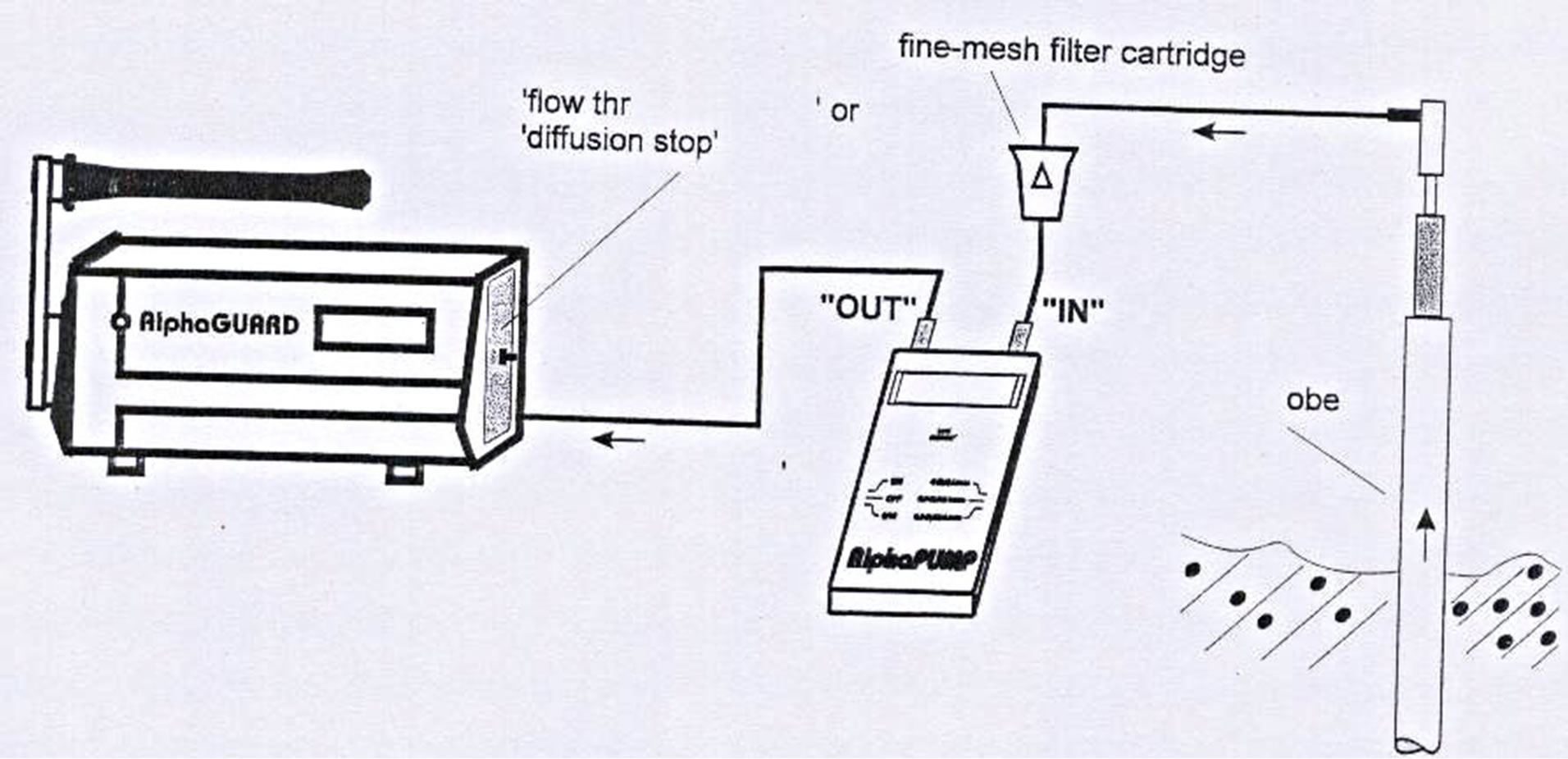
Figure 3. Alpha GUARD Measuring equipment for the determination of radon soil gas concentration.
two sedimentary rock formations: the Tabuk formation which is mainly argillacious limestones formation, which is mostly sandstone, shale and red clay (of late Permian age). The area is surrounded by sand dunes in the west and south [12]. Figure 4 shows Location map of AlQassim province in Saudi Arabia.
3. RESULTS AND DISCUSSION
An average value of Radon Activity in Bq/m3 was calculated for each sampling point. All the results were listed in Table 1, and the average radon concentrations as a function of sample point number are shown in Figures 5(a) and (b). The radioactive level of 222Rn for soil samples, as shown in Table 1, range from 340 ± 22 Bq/m3 for sample No. 3 at in Al-Tarfia at depth 60 cm under ground surface, to 26 ± 5 Bq/m3 at El-Bakria at Surface. For depth 40 the concentration varied from 79 ±10 Bq/m3 at P5 to 217 ± 22 Bq/m3 at P2. While in the depth 20 cm, the maximum Radon concentration is 175 ± 17 Bq/m3 at P10, and in Surface the maximum is 126 ±
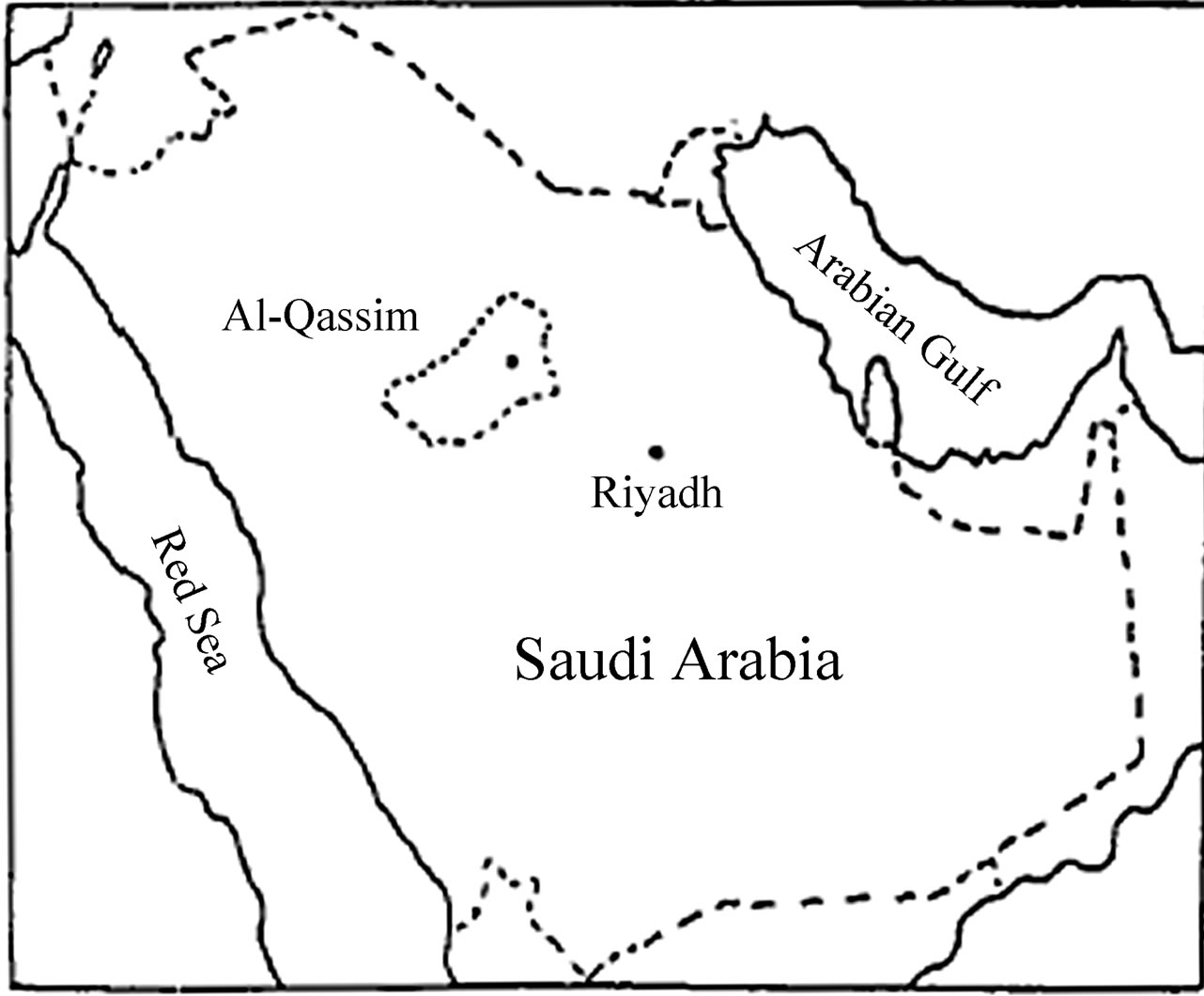
Figure 4. Location map of Al-Qassim province in Saudi Arabia.
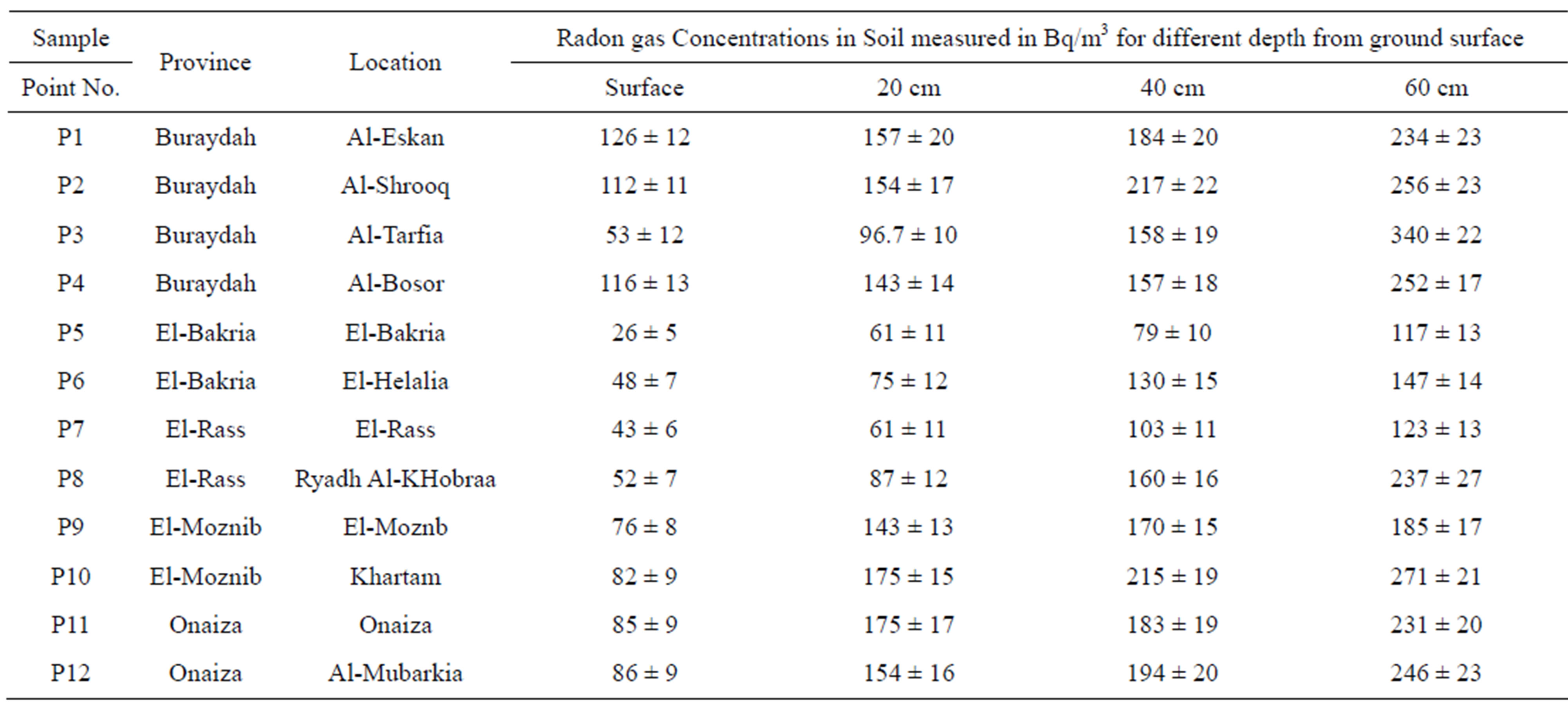
Table 1. Radon Concentrations in different depths for twelve sample points in Al-Qassiem area.
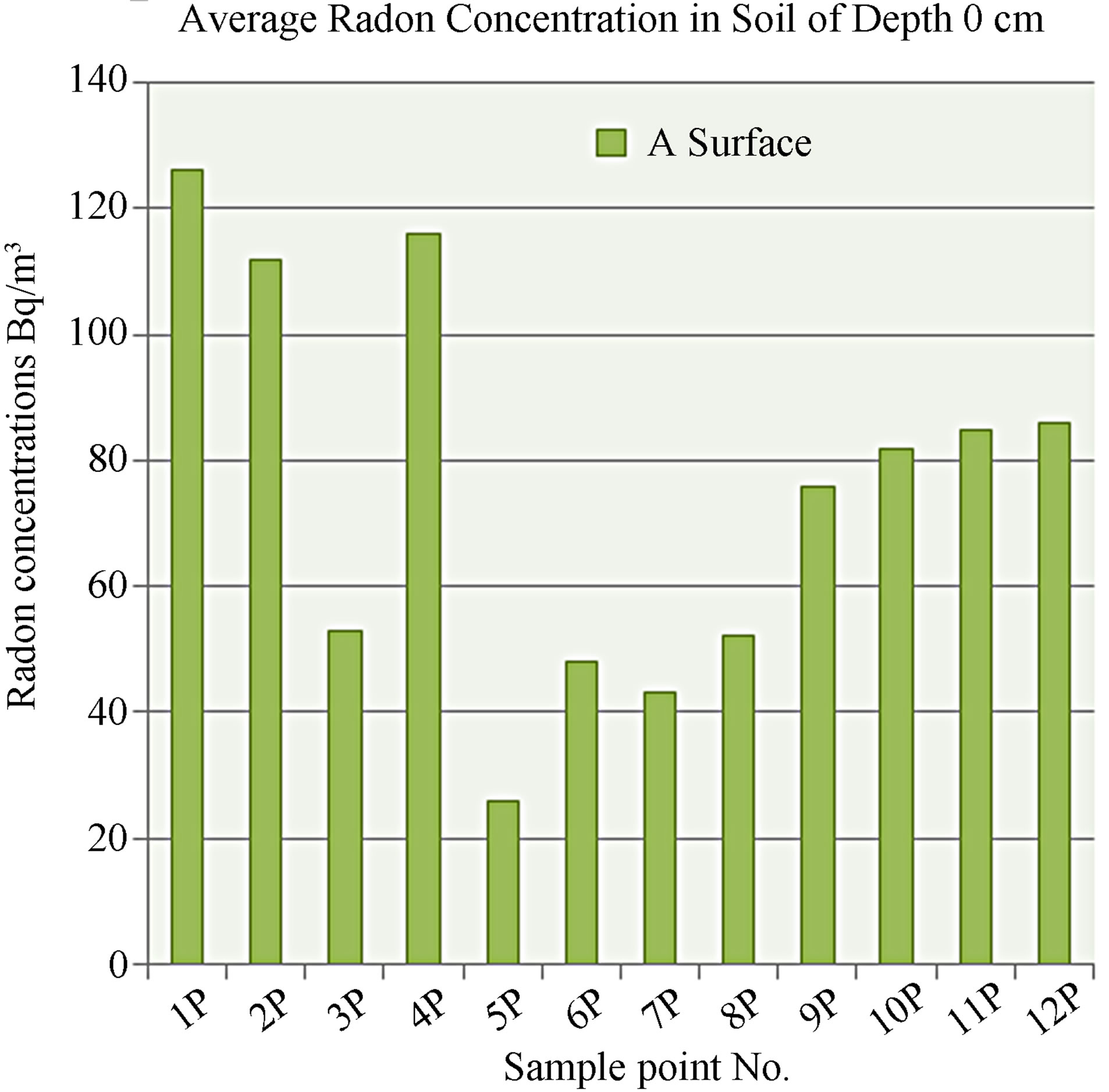 (a)
(a) (b)
(b)
Figure 5. Radon concentration as a function of the sample point number: (a) at surface 0 cm and (b) at depth 60 cm.
12 Bq/m3 at sample P1. Looking for the whole data in the table, one can see that in the majority of locations there is linearity between the radon concentrations and the depth for the same sample point as shown in the samples of data in Figures 6(a) and (b). However large variation of radon concentration in soil gas over a small depth is well known. Also it is worth to notice the sample point P5 has the minimum Radon concentration for all the four depths compared with other locations [13].
The average Radon concentration in depth 60 cm is 220 ± 19 Bq/m3, in depth 40 cm is 163 ± 16 Bq/m3, in
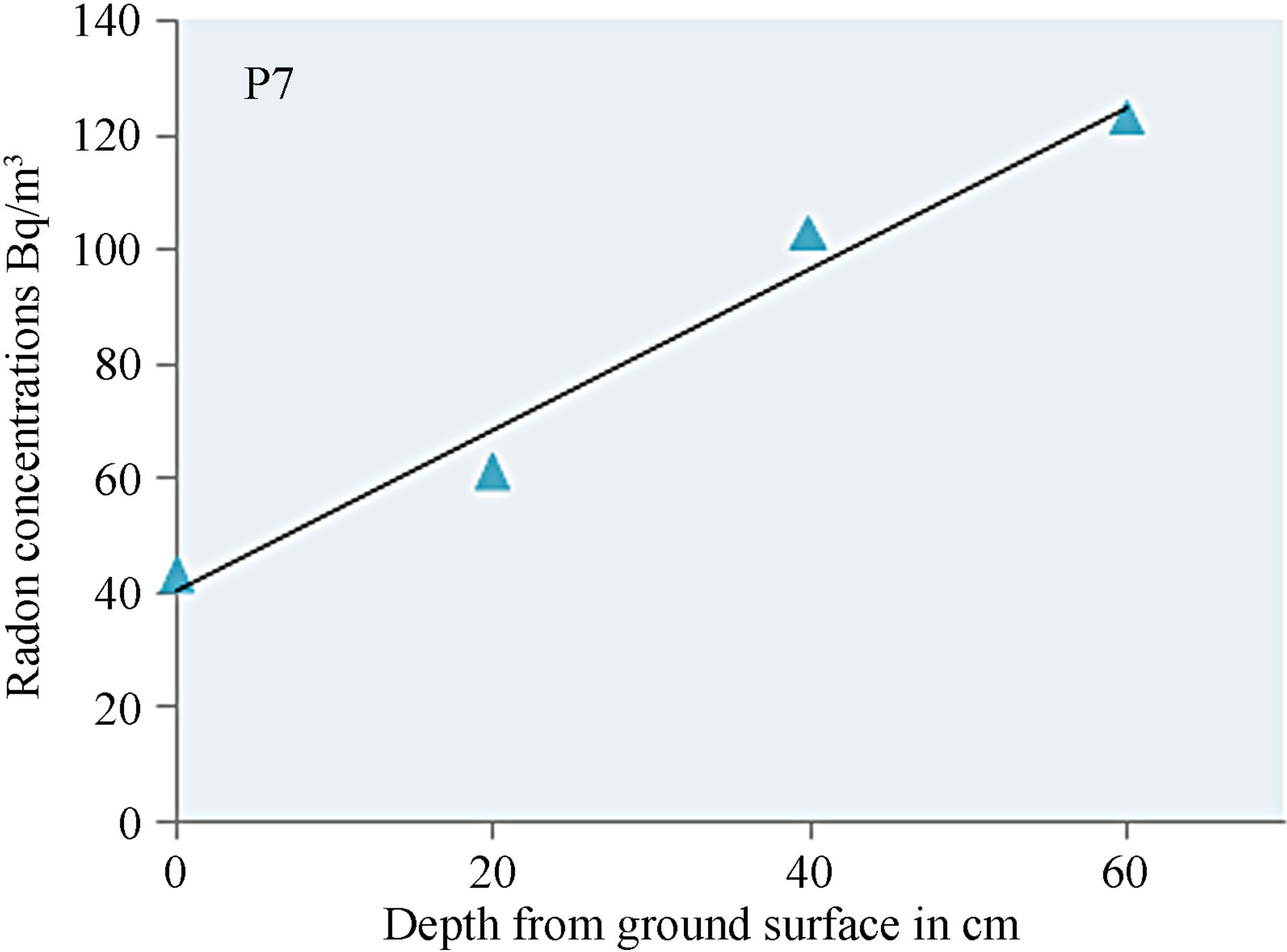 (a)
(a) (b)
(b)
Figure 6. (a) Radon concentration as a function of the depth from the ground surface: P7 for El-Rass; (b) Radon concentration as a function of the depth from the ground surface P12 for Al-Mubarkia.
depth 20 cm is 123 ± 14 and in surface 0 cm is 75 ± 9, which also looks as a linear relation with depth. The average radon concentration level in those areas, with higher depth, may be due to the presence of Uranium prospect beneath the soil.
Radon release from soils and rocks is complex. From rocks, uranium fixed in minerals along grain boundaries and in defects is susceptible to leaching, thus releasing radon trapped therein. In soils, radon release is affected by moisture content, permeability, porosity, temperature, and other factors. Each site may have distinct characteristic rock and soil properties and must be evaluated accordingly [14].
Estimate of the Natural Radiation Exposure
When exposure to radon (and radon progeny) is to be compared to the exposure from other radiation sources, it is necessary to estimate the effective dose per unit radon gas exposure. In the past this has predominantly been done by using the dosimetric evaluation of the absorbed dose to basal cells of the bronchial epithelium and applying the ICRP convention for calculating effective dose (effective dose equivalent). The indoor radon concentration is expressed in terms of equilibrium-equivalent radon concentration (EECRn) by using the following relation:

Were F is the equilibrium factor (F = 0.45) and ARN is the measured indoor radon activity. The equivalent dose received by bronchial pulmonary regions of human lungs has been calculated using a conversion factor 1.0 × 10−5 mSv per Bq∙h/m3.
Because of their different physical properties, radon gas and radon decay products are considered separately. Inhaled radon, being a noble gas, is constantly present in the air volume of the lungs at the concentration in air (XRn,air) and is partly dissolved in soft tissues. Taking the solubility factor for soft tissues to be 0.4 and assuming that the short-lived decay products decay in the same tissue as radon gas, the following relationship for soft tissues other than the lungs was derived [15]:

In the case of the lungs, in addition to the dissolved radon, the radon content of air in the lungs must be taken into account. Assuming the air volume in the lungs to be 3.2 × 10−3 m3 for the “Reference Man” and assuming further that the short-lived decay products will stay in the lungs, the dose rate due to alpha-radiation was determined as [15,16]:

Taking a quality factor of 20 for alpha-radiation and applying a weighting factor of 0.12 for the lungs and of 0.88 for other tissues, the effective dose equivalent rate was calculated as

An average value of the equilibrium-equivalent radon concentration (EECRn) and the annual effective dose were calculated for each sampling point. All the results were listed in Table 2, and illustrated in Figure 7 and Table 3 show Variation of dose relationship from radon measurements from soil surface in Al-Qassim area.
Soil moisture plays an important role in the emanation of radon and its diffusion in soil, for several reasons. Soil moisture, in the form of a thin film of water surrounding soil grains, directly affects radon emanation by capturing the radon recoils from the solid matrix. These captures increase the likelihood that radon atoms will remain in

Table 2. EEC and annual effective dose of 222radon from soil in Al-Qassim area.
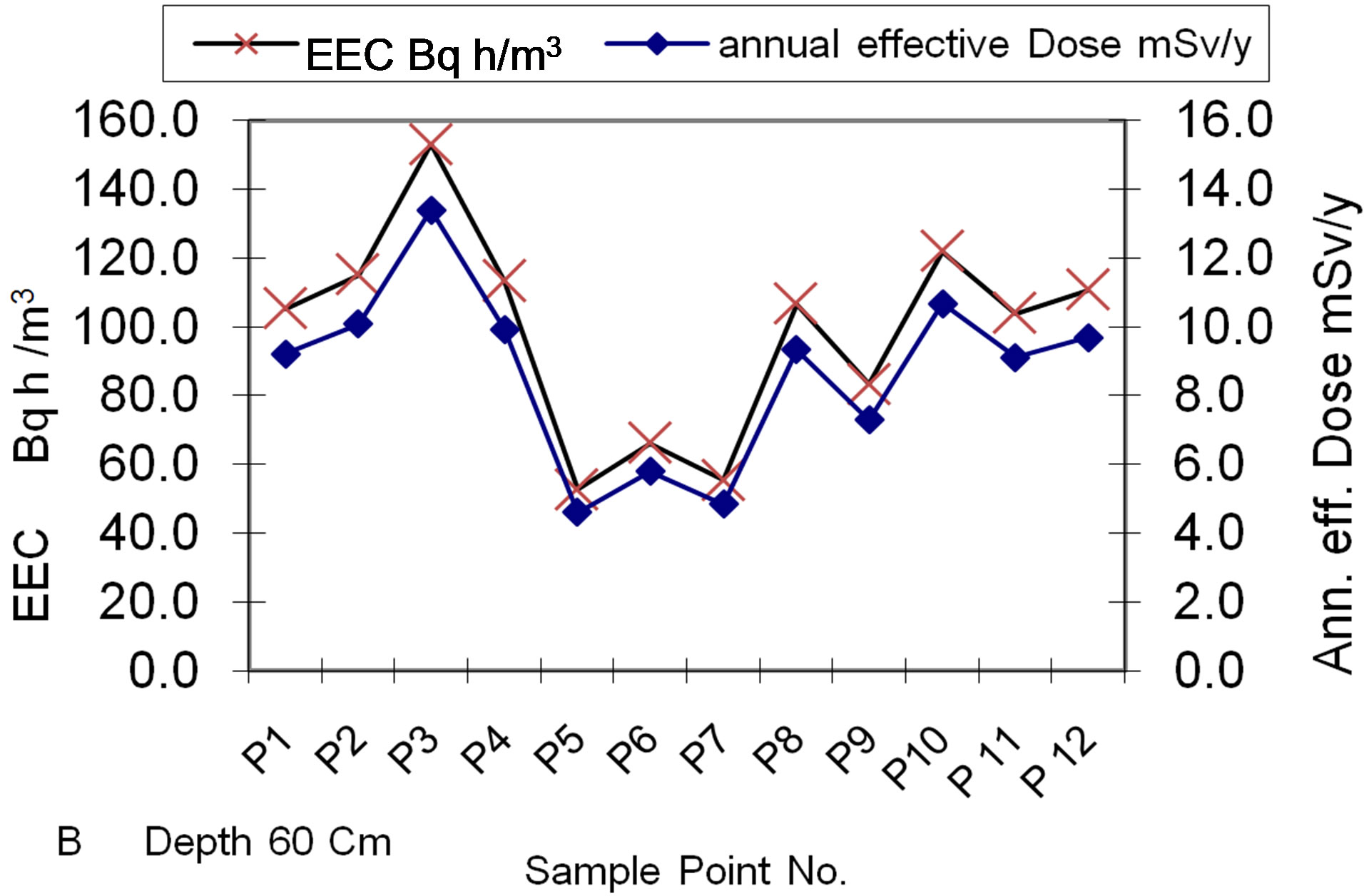
Figure 7. Average annual equilibrium equivalent daughter concentrations (EEC) and Dose mSv/y versus samples point No. for surface soil in Al-Qassim area.

Table 3. Variation of dose relationship from radon measurements for soil surface in Al-Qassim.
the pore space instead of crossing the pores and imbedding themselves in adjacent soil grains. Both theoretical estimates and laboratory tests show that adsorption on soil grains decreases rapidly with increasing water content, becoming insignificant for water contents greater than about 0.3 - 0.4 of saturation [1]. Decreased adsorption increases the emana tion factor at low water contents. Once radon enters the pore space, its partition between the gas and liquid phases depends on the relative volume of water in the pore space and on temperature. The solubility of radon in water decreases with temperature. The partition coefficient of radon between water and gas, the Ostwald coefficient KT, gives the ratio of concentrations of radon in water and in air. The value of KT varies from 0.53˚C at 0˚C to 0.23˚C at 25˚C in water and is typically 0.30˚C at 15˚C. Both partitioning and increased emanation cause the concentration of radon in the air-filled pores to be higher under moist conditions than under dry conditions [17].
4. CONCLUSION
The most important radon isotope from a health viewpoint is 222Rn. Its decay products, especially 218Po and 214Po, can have a pronounced adverse effect on lung tissues, leading to lung cancer in many cases. In the present investigation we measured 222Rn concentration in AlQassim area soil. The results in the present work indicate that the area under investigation has different Radon concentrations according to depth from the ground surface and the locations of the sample point. The concentration increases with depth from the ground surface. The results, in average, are less than the reported average in Kurdistan Iraq or in Jordan. The continuous monitoring, Alpha GUARD 2000 PRQ probes, are a simpler and fast method of measuring the Radon gas concentration in soil. This kind of measurements, together with permeability of soil, can be helpful in complying new radiation protection regulation to estimate health hazard index due to radiation exposure in Saudi Arabia.
5. ACKNOWLEDGEMENTS
This project was funded by the Deanship of Scientific Research (DSR), King Abdulaziz University, Jeddah, under grant No.(364/363/ 1432) . The authors, therefore, acknowledge with thanks DSR technical and financial support..
REFERENCES
- UNSCEAR (2000) Sources and effects of ionising radiation. Report to the General Assembly, United Nations Scientific Committee on the Effects of Atomic Radiation, New York.
- UNSCEAR (1993) Sources and effects of ionizing radiation. United Nations Scientific Committee on the Effects of Atomic Radiation, New York.
- Abbady, A., Abbady, A.G.E. and Michel, R. (2004) Indoor radon measurement with The Lucas cell technique. Applied Radiation and Isotopes, 61, 1469-1475. doi:10.1016/j.apradiso.2004.03.065
- EPA (1994) Reducing radon in Schools: A team approach. Air and Radiation, EPA 402- R-94-008, 1994.
- Abu-Jarad, F. and Al-Jarallah, M.I. (1986) Radon in Saudi Arabia. Radiation Protection Dosimetry, 14, 243-249.
- Abu-Jarad, F., Fazal-ur-Rehman, Al-Jarallah, M.I. and AlShukri, A. (2003) Indoor radon survey in dwellings of nine cities of the eastern and the western provinces of Saudi Arabia. Radiation Protection Dosimetry, 106, 227- 232. doi:10.1093/oxfordjournals.rpd.a006353
- Al-Jarallah, M.I. and Fazal-ur-Rehman (2006) Indoor radon concentration in the dwellings of Al-Jauf region of Saudi Arabia. Radiation Protection Dosimetry, 121, 293- 296. doi:10.1093/rpd/ncl023
- Al-Jarallah, M.I. and Fazal-ur-Rehman (2005) Anomalous indoor radon concentration in a dwelling in Qatif city, Saudi Arabia. Radiation Protection Dosimetry, 117, 408- 413. doi:10.1093/rpd/nci307
- Al-Anazi, M.D. (2002) A seasonal study for the determination of radon concentration in different areas in Riyadh city in Saudi Arabia. M.S. Thesis, King Saud Uinversity, Riyadh.
- Al-Yami, S.H. (2008) Measurement of radon concentration in housed in Najran Region, Saudi Arabia. M.S. Thesis, King Saud Uinversty, Riyadh.
- UMPRMA (1998) User Manual Portable Radon Monitor Alpha GUARD (1998) Genitron Instruments GmbH, Germany
- Garawi, M.S. (1996) Measurement of radon conconcentrtion in private houses in the eastern part of AlQaseem province of Saudi Arabia. Radiation Protection Dosimetry, 63, 227-230. doi:10.1093/oxfordjournals.rpd.a031534
- Varley, N.R. and Flowers, A.G. (1998) The influence of geology on radon levels in S.W. England. Radiation Protection Dosimetry, 77, 171-176. doi:10.1093/oxfordjournals.rpd.a032307
- Douglas, G.B. (1990) The indoor radon problem. Columbia University Press, New York.
- ICRP (1981) Limits for inhalation of radon daughters by workers. International Commission on Radiological Protection, Ottawa.
- ICRP (1993) Protection against radon-222 at home and at work. Pergamon Press, Oxford.
- El-Taher, A. (2012) Measurement of radon concentration and their annual effective dose exposure in groundwater from Qassim area, Saudi Arabia. Journal of Environmental Science and Technology, in press.

